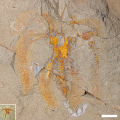Larvae of ancient arthropods lived similarly to their adults
An international team of paleontologists led by Lukáš Laibl of the Institute of Geology of the Czech Academy of Sciences and Allison C. Daley of the University of Lausanne studied tiny, 480 million years old, arthropod larvae. They scanned these fossils using a powerful X-ray scanner at the Paul Scherrer Institute in Switzerland to study them in detail. The results show that the development of these ancient arthropods was very simple, with no fundamental changes in the mode of life. Larvae and adults were living at the same place, feeding in a similar way. This contrasts with the development of most of today's arthropods whose larvae often live differently from the adults. Early arthropods likely had a simple type of development, while more complex life cycles evolved independently later in this animal group.


